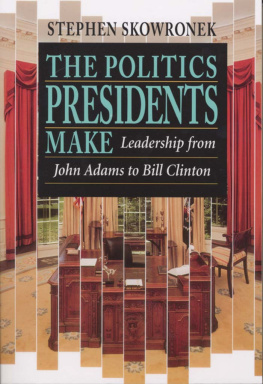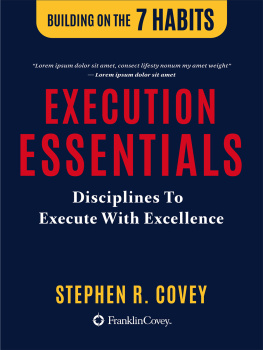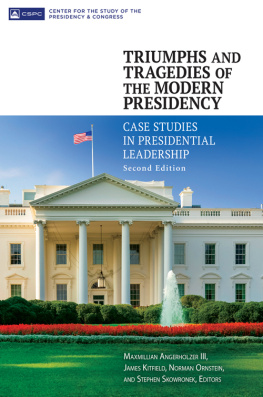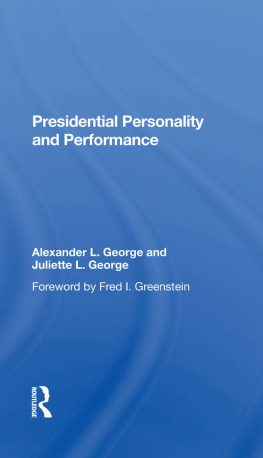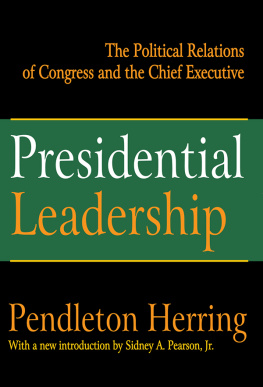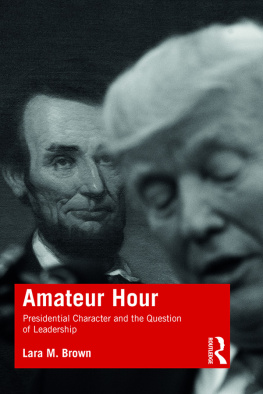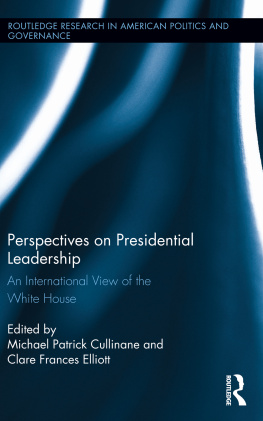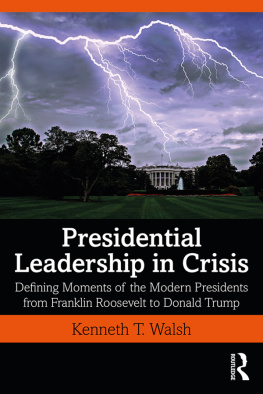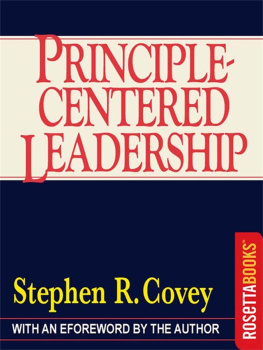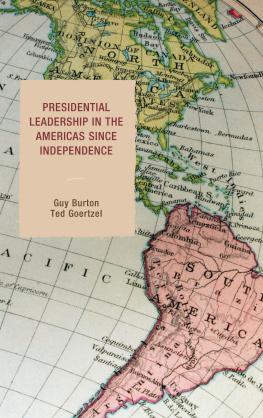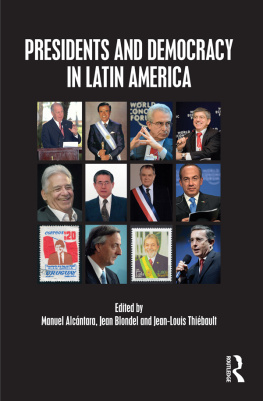Stephen Skowronek - Presidential Leadership in Political Time : Reprise and Reappraisal?
Here you can read online Stephen Skowronek - Presidential Leadership in Political Time : Reprise and Reappraisal? full text of the book (entire story) in english for free. Download pdf and epub, get meaning, cover and reviews about this ebook. year: 2011, publisher: University Press of Kansas, genre: Politics. Description of the work, (preface) as well as reviews are available. Best literature library LitArk.com created for fans of good reading and offers a wide selection of genres:
Romance novel
Science fiction
Adventure
Detective
Science
History
Home and family
Prose
Art
Politics
Computer
Non-fiction
Religion
Business
Children
Humor
Choose a favorite category and find really read worthwhile books. Enjoy immersion in the world of imagination, feel the emotions of the characters or learn something new for yourself, make an fascinating discovery.

- Book:Presidential Leadership in Political Time : Reprise and Reappraisal?
- Author:
- Publisher:University Press of Kansas
- Genre:
- Year:2011
- Rating:3 / 5
- Favourites:Add to favourites
- Your mark:
- 60
- 1
- 2
- 3
- 4
- 5
Presidential Leadership in Political Time : Reprise and Reappraisal?: summary, description and annotation
We offer to read an annotation, description, summary or preface (depends on what the author of the book "Presidential Leadership in Political Time : Reprise and Reappraisal?" wrote himself). If you haven't found the necessary information about the book — write in the comments, we will try to find it.
Presidential Leadership in Political Time : Reprise and Reappraisal? — read online for free the complete book (whole text) full work
Below is the text of the book, divided by pages. System saving the place of the last page read, allows you to conveniently read the book "Presidential Leadership in Political Time : Reprise and Reappraisal?" online for free, without having to search again every time where you left off. Put a bookmark, and you can go to the page where you finished reading at any time.
Font size:
Interval:
Bookmark:
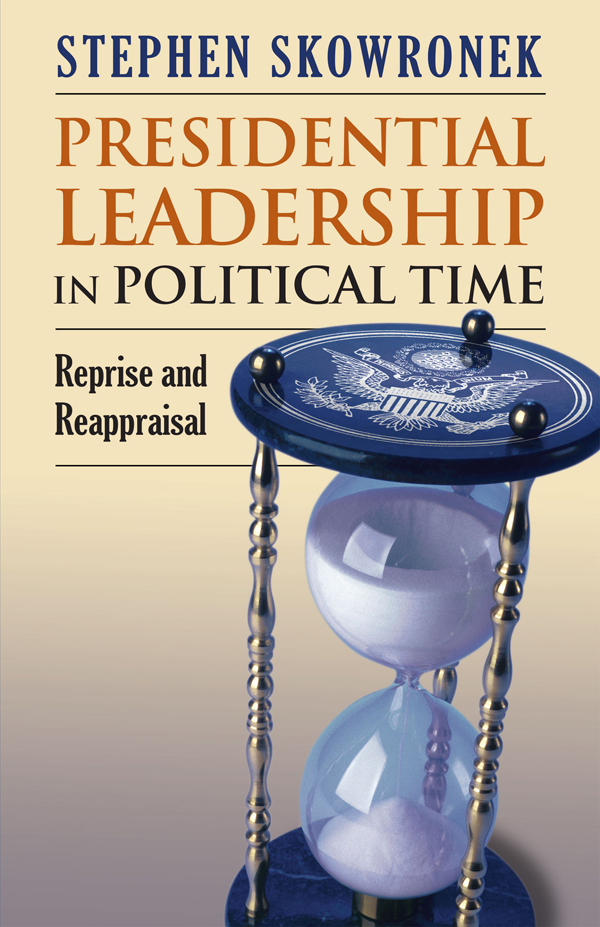
Presidential Leadership
in Political Time
Presidential Leadership
in Political Time
reprise and reappraisal
Second Edition, Revised and Expanded
Stephen Skowronek
 University Press of Kansas
University Press of Kansas
2008, 2011 by the University Press of Kansas
All rights reserved
Published by the University Press of Kansas (Lawrence, Kansas 66045 ), which was organized by the Kansas Board of Regents and is operated and funded by Emporia State University, Fort Hays State University, Kansas State University, Pittsburg State University, the University of Kansas, and Wichita State University
Library of Congress Cataloging-in-Publication Data Skowronek, Stephen.
Presidential leadership in political time : reprise and reappraisal /
Stephen Skowronek. 2nd ed., rev. and expanded.
p. cm.
Includes bibliographical references and index.
ISBN 978-0-7006-1783-8 (cloth : alk. paper)
ISBN 978-0-7006-1762-3 (pbk. : alk. paper)
ISBN 978-0-7006-2245-0 (ebook)
1. PresidentsUnited States. 2. PresidentsUnited StatesHistory.
3. Political leadershipUnited States. 4. Political leadershipUnited StatesHistory. 5. Bush, George W. (George Walker), 1946
6. United StatesPolitics and government20012009. I. Title.
JK516.S56 2011
352.23'60973dc22
2010044912
British Library Cataloguing-in-Publication Data is available.
Printed in the United States of America
10 9 8 7 6 5 4 3 2 1
The paper used in this publication is acid-free and contains percent postconsumer waste. It meets the minimum requirements of the American National Standard for Permanence of Paper for Printed Library Materials Z39.48-1992 .
To Michael and Sam
Contents
Preface to the Second Edition
The themes that thread their way through the essays in this collection first appeared in book form nearly twenty years ago. The Clinton presidency was taking shape just at the time I was finishing that work, and I recall feeling a bit uneasy at the thought that readers might be more interested in the final comment I was dashing off about this new man on the scene than in anything I had said in the prior four hundred pages about the politics of leadership from John Adams to George H. W. Bush. It was easy enough for me to describe Bill Clintons leadership in the terms set out in the book, for in his rise to power, he fit to a T one of the historical types I had distinguished. Taking the Democrats to their first national victory since the Reagan Revolution, submerging his partys liberalism in the promise of a third way, winning the presidency in a three-way race with about 40 percent of the popular vote, Clinton epitomized what I had called preemptive leadership. But therein lay the source of my unease. I had observed in the book that preemptive leaders were prone to spark constitutional showdowns, even impeachment proceedings, and I was loath to close out my long labors with outlandish predictions. Who would have thought that a mechanical extrapolation of the most extreme implications of my thesis would have been right on the money and that scholarly prudence would prove the lesser part of wisdom?
Readers of that earlier book would not have had any difficulty identifying Clintons successor either. Bringing the party of Ronald Reagan back to power, George W. Bush promised to complete the work the conservative insurgency had started, to adapt its agenda to a new day, and to demonstrate the enduring vitality of its governing commitments. He exemplified what I had called the president as orthodox innovator. Like everyone else, however, I thought that the events of 11 September 2001 would change everything, presidential leadership first and foremost. This was exactly the kind of contingency that scholars have in mind when they caution against projecting historical patterns lockstep into the future. One of the things I had observed about orthodox innovators was that they were prone to engage in little wars of dubious provocation, muscle-flexing adventures driven more by ideology and political management than by necessity. This president, in contrast, was being called on to respond to a concerted and destructive attack on the homeland; there was nothing in his avowed determination to eradicate al Qaeda and its sponsors in Afghanistan to support the designation my analysis would have assigned him. Then came the turn to Iraq, with its shaky presuppositions, headstrong assertions, and political bluster, and things did not seem quite so different after all.
Clinton and Bush turned out to be such eerily vivid exemplars of leadership types and political patterns I had identified in The Politics Presidents Make that I thought it might be worth putting together a short collection of essays that would revisit the themes presented in that book and draw them forward. This is the second edition of these essays, which now include an early assessment of Barack Obama as well. The essay format has several advantages: It makes the political time thesis more readily accessible; it offers a flexible structure for updating the thesis; and it preserves the integrity of the original presentation by preventing the earlier book from becoming overrun by a succession of postscripts and addendums. Each of the essays in this collection is a sufficiently self-contained elaboration of the thesis to be read independently or in any combination with the others. Anyone who cares to read them all in the order presented should get a pretty good idea of the development and analytic reach of the argument.
As I indicate in the opening of each chapter, these essays were all prepared for other occasions and written at different junctures in contemporary American political history. All have been edited for this volume to bring them into better alignment with one another, and some have been revised quite thoroughly. I have, however, resisted the temptation to integrate them completely, for that would have meant eliminating the sense of the moment in which each essay was written, and it would have suggested a more definitive reformulation of the thesis than I intend. Preserving the spirit of each assessment as it was ventured at the time better conveys my attitude toward the thesis, which is one of open-ended and continual reappraisal in light of late-breaking developments. I think a thesis like this onewhich identifies broad historical patterns in presidential leadership and explains the political dynamics at work behind themis most interesting in pointing up contemporary expressions of difference and potentially significant deviations from the rule. As the essays collected here indicate, I am less inclined to insist that these patterns never change than to figure out how they might.
Presidential leadership in political time is a window on the institution of the presidency and the workings of the American political system as a whole. The approach calls attention to the often-stark variations we observe in leadership performances from one president to the next, but it resists the temptation to reduce these differences to matters of personality and style or to cull from them some ideal formula for successful leadership in contemporary America. Rather than dwelling on what one incumbent seemed to do right or where another fell short, the perspective of political time refers us back to the politics of leadership in earlier periods, to prior sequences of change in which presidents took on similar challenges in leadership and wrestled them to similar political effect. The recurrent patterns revealed in this way indicate the historical range of political possibilities for presidential leadership in the American system. At issue here is not what we might want presidential leadership to be, but what its capacities are and how it has operated in political circumstances variously configured. The perspective captures the typical political problems the American system throws up to its leaders and the likely political effects of their efforts to resolve them.
Font size:
Interval:
Bookmark:
Similar books «Presidential Leadership in Political Time : Reprise and Reappraisal?»
Look at similar books to Presidential Leadership in Political Time : Reprise and Reappraisal?. We have selected literature similar in name and meaning in the hope of providing readers with more options to find new, interesting, not yet read works.
Discussion, reviews of the book Presidential Leadership in Political Time : Reprise and Reappraisal? and just readers' own opinions. Leave your comments, write what you think about the work, its meaning or the main characters. Specify what exactly you liked and what you didn't like, and why you think so.

